Table of Contents
CAE Use of English Part 1
The first video on this page teaches you the technique I recommend using for the CAE Use of English part 1. While listening to the video, you can complete a CAE Listening part 1 exercise based on the information we learn. You can follow the instructions in the video, but I will put a script and the questions to answer below the video as well.
Exercise
Here are some questions that you should answer based on what you listened to in the video above:
Extract 1
- How many options can you choose from to fill the gap?
A 3
B 4
C 2
- How many questions will you answer?
A 6
B 8
C 10
Extract 2
- What is the second step in the technique:
A Read the whole passage
B Guess the missing word
C Underline the words in the options
- What will help you get the right answer:
A knowledge of the topic
B experience of English exams
C knowledge of word families
Extract 3
- What will help you get the right answer:
A identifying the type of words in the (a-d) options
B the intonation of the sentence
C reading the sentence 4 or 5 times
- What are collocations?
A a type of word
B a combination of words
C phrasal verbs
Answers
- B
- B
- B
- C
- A
- B
This is the type of exercise you will face in part 3 of the CAE listening paper…so you were simultaneously training 2 parts of the exam just then 😉
Video Script
Here is the script that we listened to in the video above:
“Extract 1
In part 1 of the Reading and Use of English paper, you have to fill 8 gaps in a text.
You choose which word fills the gap from four options (A,B,C,D).
The four (A-D) options often have very similar meanings and you have to decide which is most appropriate.
Technique
Extract 2
- Skim the text very quickly because it’s good to understand the overall topic/meaning.
- Identify the gap. Do you think you know the word already?
- Look at the a-d options and see if any match your thinking.
- Identify the type of word: noun/adjective/verb etc. Your understanding of English word families and sentence structures will help with this.
Extract 3
- Look at the a-d options and see if any match the type of word you identified.
- Decide which one fits with the meaning/sound of the sentence. Your knowledge of collocations is tested throughout much of the exam. Collocations are a couple of words which are commonly used together. For example: ‘interested in’. In English we say “I am interested in….” rather than “I am interested of…”
Extra Use of English Tip: this is available for Gold members only. Register/upgrade to Gold membership with a discount here >>
CAE Use of English Part 1 Exercise
Okay, hopefully you now have a good understanding of part 1 of the Reading and Use of English paper. So now we can practise this part.
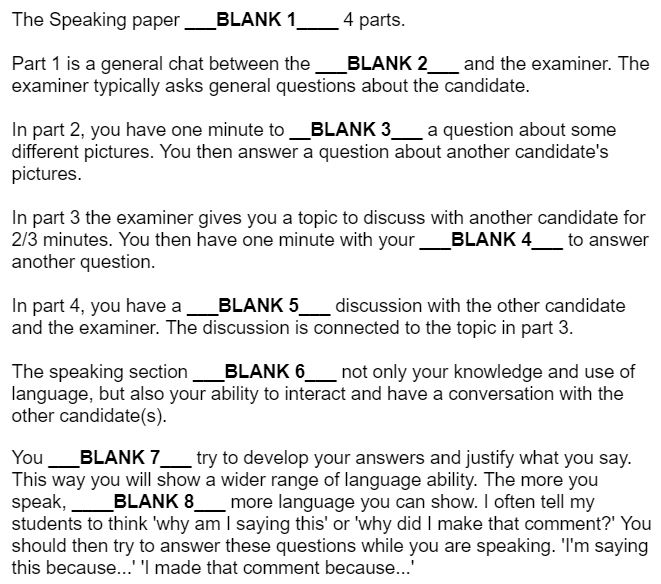
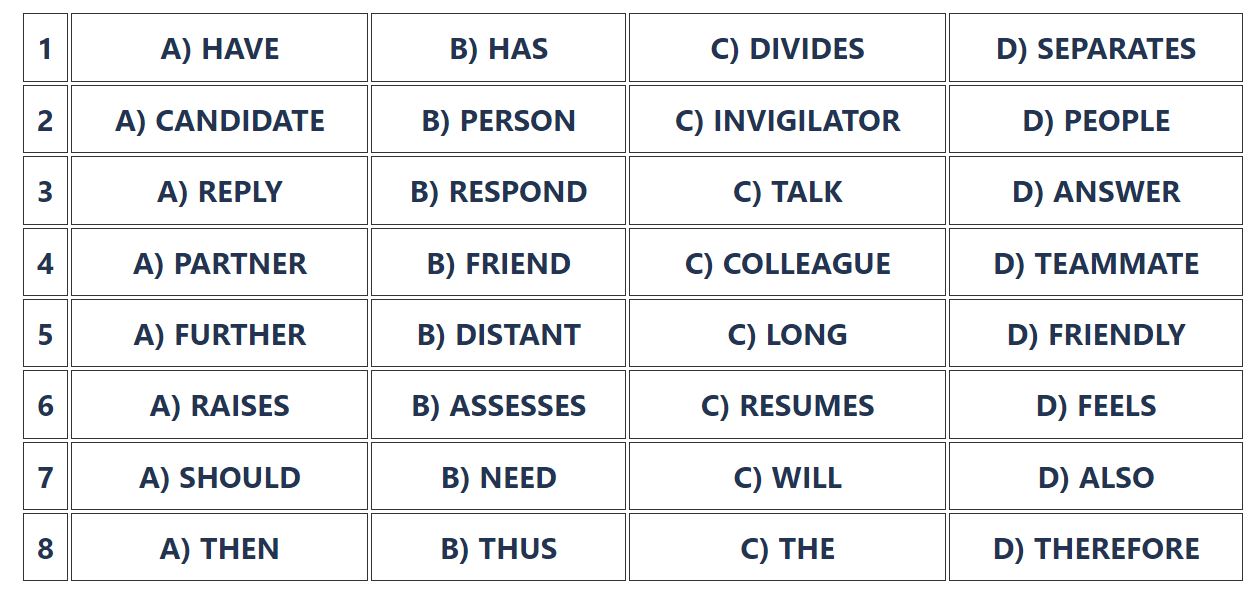
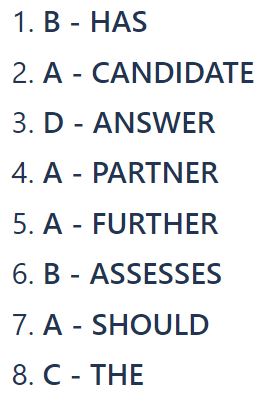
More Exercises
The following video is a really popular dictation I did from a CAE Use of English part 1 sample paper. At the end of the video I ask you to complete the questions using the technique I teach you. This helps you practice for the CAE Use of English part 1 while at the same time improving your listening, writing, reading, spelling and grammar skills. Dictations are a great way to learn, if you want to learn why, click here. Otherwise, follow and complete the exercises on the rest of this page:
I hope you have now watched and learnt the technique so we can continue to practise it with some more dictation style videos.
You can compare your writing with my passage and the options from the video here. After that, you will find another video where I explain why the answers are correct in more detail:
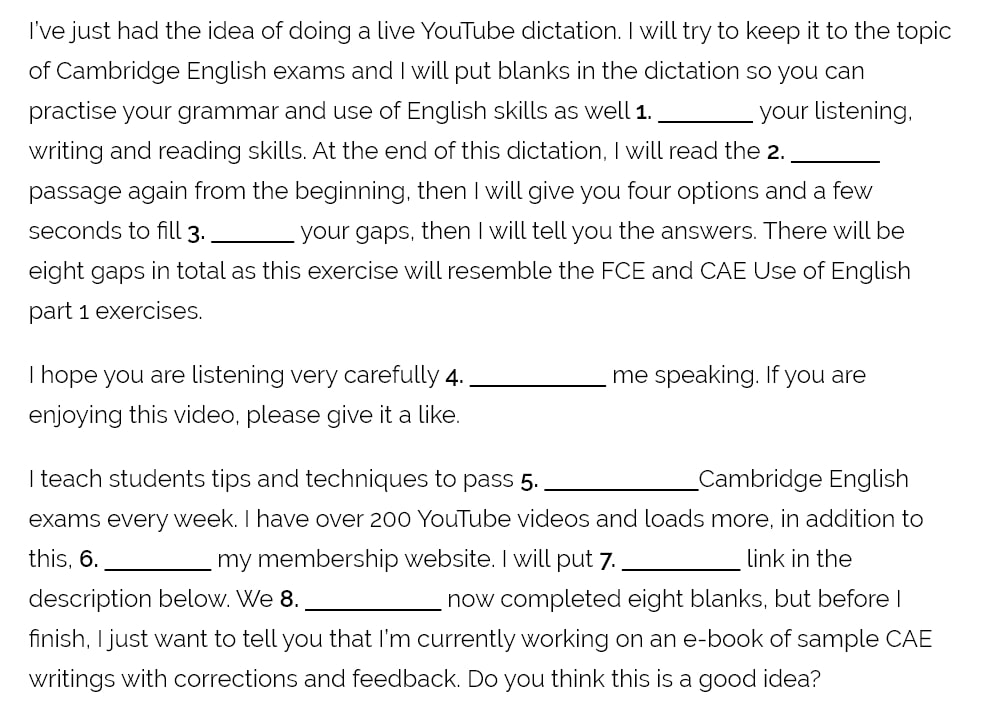
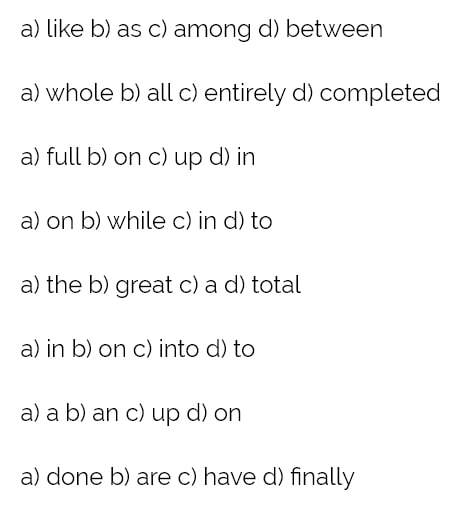
CAE Use of English Part 1 Answers
Here is a picture of the completed passage with the answers:
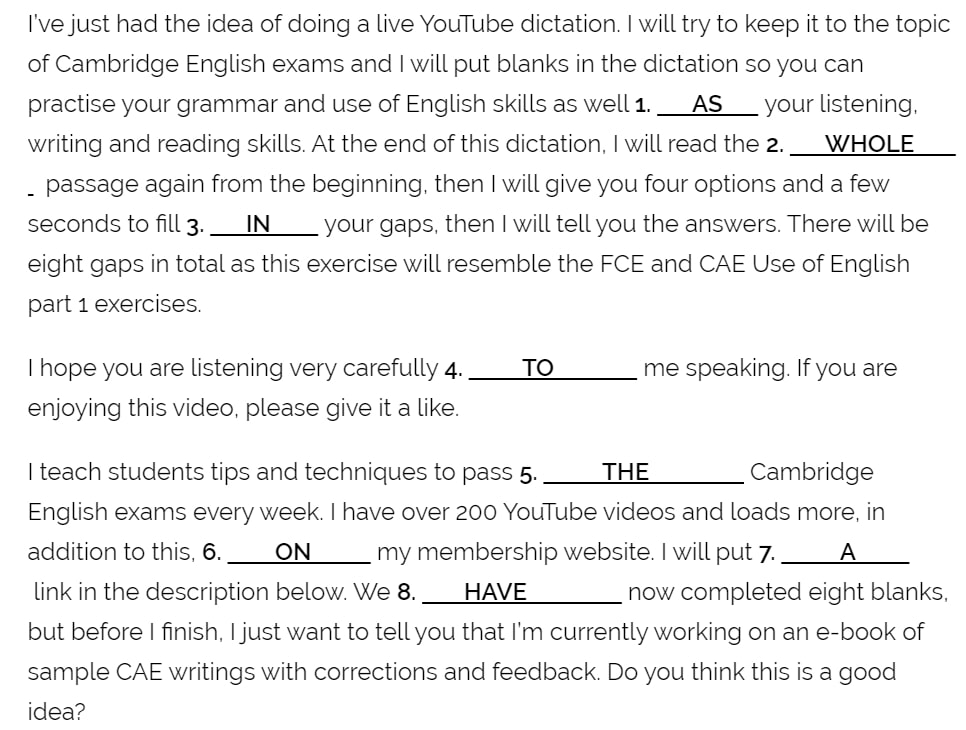
Use of English Multiple-choice Cloze Explanations
I started explaining the explanations for the answers to this exercise in writing. But it was taking a really long time, so I only completed the first two. Anyway, you might find it useful to read as there are some detailed and important points…
Question 1
Correct answer = B ‘as’
Let’s assume for that you’ve used my technique for question 1 and you were not sure which word fit the gap initially and you were also unable to identify the type of word. Now we must rely on the meaning of the sentence.
I think we need a word which helps explain that my dictations will improve my grammar and Use of English skills as an extra to my reading etc. skills.
So, we need a word which means something extra or something in addition to another thing.
If we used the word ‘like’ in this sentence, it might have worked if there was a comma before the word, but there is not comma before it and without this, ‘like’ means ‘similar to’. That does not fit the meaning of the sentence.
The words ‘among’ and ‘between’ imply that we learn grammar and use of English within or as part of our listening, writing and reading skills. But the writing does not mean this. It means we will improve our grammar and use of English separately, because of the blank spaces. So ‘among’ and ‘between’ do not fit with the meaning of the sentence.
The words ‘as’ and ‘well’, are often followed by the word ‘as’ again. In this situation the second ‘as’ may be acting as a conjunction and it might mean an addition to or an extra to something.
For example:
“I completed the dictation exercise as well as the Use of English exercise.” This means I completed both exercises. “I completed the dictation exercise in addition to the Use of English exercise”.
This meaning is the most suitable meaning for this question:
“I will put blanks in the dictation so you can practise your grammar and use of English skills as well 1. as _ your listening, writing and reading skills.”
“I will put blanks in the dictation so you can practise your grammar and use of English skills in addition to your listening, writing and reading skills.”
Studying collocations and understanding word families and sentence structures are really important for getting high marks in the Use of English paper:
More meanings for ‘as’
- The word ‘as’ could be acting as an adverb. In this case, it would mean somebody does something to an equally good standard as someone else.
For example:
“she plays football as well as he does”.
This means they completed the dictation exercise to the same high quality standard.
2. Similar to meaning 1 above, we commonly use ‘as + adjective + as’ to show a comparison when two things are the same.
For example:
“My house is as tall height as my neighbour’s house” which means “my house is the same height as my neighbour’s house”.
In situations 1 and 2 above, if you see the words ‘as well’ in an exercise, followed by a blank space, you will most probably need to fill that blank space with the word ‘as’.
3. We also commonly find as + well at the end of a sentence to show something is in addition.
For example:
“I went to the gym and I went to the cinema as well.”
Question 2
Let’s say I’ve complete steps 1, 2 and 3 of my technique but I don’t know which word fits the gap. So, I’ve moved onto step 4 and because I’ve studied sentence structures, I know that the word we need is describing the noun after it. Words which describe nouns in English are adjectives.
For this reason, I can rule out the adverb ‘entirely’. An adverb is not suitable here.
I haven’t studied types of words well enough and I think that the other three options are all adjectives. This is actually not true, ‘all’ is classified as a determiner rather than an adjective, but let’s pretend I think it’s an adjective. Therefore I will move on to step 6 and think about the meaning of the sentence.
The passage is not ‘completed’, it has gaps in it. So ‘completed’ is not the correct answer because the meaning does not fit.
This leaves me with ‘all’ and ‘whole’. At this point, if I don’t know the correct word, I will have to guess. But because I’ve followed the technique, at least I now have a 50:50 chance of getting it right rather than a 25% chance.
As I am an English teacher, I can tell you that the correct answer is ‘whole’ and this is because of the position of the words in the sentence. As I said earlier, understanding word families and sentence structures is really important for the Use of English paper.
The structure you need to use here is ‘the + whole + noun’. Here are some more examples of this structure:
“They decided to go to the monastery with the whole family”
“The whole family is/are here in France”
“The whole government is/are”
“The whole cake is covered in candied fruits”.
Understanding ‘whole’
You could also use a different determiner before ‘whole’ in this situation:
“My whole wardrobe is full of black clothes.”
“Our whole refrigerator is full of healthy food.”
When we use whole with plural nouns, it means ‘complete’ or ‘entire’.
“Whole families are staying at home in France.” This means entire families: husbands, wives, children etc.
“Whole groups of monkeys are eating bananas.” This could mean 5 groups, but every monkey in the group is eating a banana.
We can’t omit (remove) ‘the’ before ‘whole’ with a singular noun.
“The whole family”
“The whole government”
Understanding ‘All’
You cannot say ‘the + all + noun’ in English.
The nearest sentence structure you can use with ‘all’ is ‘all + the/determiner + noun’.
Here are some examples of this form:
“All ‘our/the’ family are here in France.”
“All Russian people are sitting at home in Moscow now.”
“All our children like porridge for breakfast.”
“All our clients like our colours.”
“All spring birds sing all day long.”
You can also use ‘all’ before plural nouns and then it means ‘each and every’. Here are some examples:
“All families are staying at home in Moscow. This means every family is at home.”
“All monkeys eat bananas. This means every monkey is eating a banana.”
“All men read the newspaper at breakfast.”
“All women like checking/going on/ instagram.”
You shouldn’t use ‘all’ before ‘a’ or ‘an’:
“All a family”
“All a person”
Here is a quick summary of the rest of the answers:
Question 3
“then I will give you four options and a few seconds to fill 3. your gaps, then I will tell you the answers”
a) full b) on c) up d) in
2. Do you know the word? No.
3. Do any match your thinking?
4. What type of word? Phrasal verb. Preposition.
5. Do any match the type? Yes.
a) full b) on c) up d) in
6. Meaning/sound.
a) full b) on c) up d) in
I have never heard ‘Fill on’.
‘Fill up’ = make full.
‘Fill in’ = British English = forms.
Question 4
“I hope you are listening very carefully 4. me speaking.”
a) on b) while c) in d) to
2. Do you know the word? No.
3. Do any match your thinking?
4. What type of word? Collocates with ‘listen + __ + person’. Preposition.
5. Do any match the type? Yes.
6. Meaning/sound.
a) on b) while c) in d) to
75% chance.
Listen + to + someone
Question 5
“I teach students tips and techniques to pass 5. Cambridge English exams every week.”
a) the b) great c) a d) total
2. Do you know the word? ‘the’?
3. Do any match your thinking?
4. What type of word? Article or adjective.
5. Do any match the type? Yes.
6. Meaning/sound.
Why not ‘c’?
Article + plural noun ‘exams’.
Why not ‘b’ or ‘d’?
Meaning.
‘B’ is subjective.
‘D’ is strange. I don’t teach tips for ‘total’ exams every week.
Question 6
“I have over 200 YouTube videos and loads more, in addition to this, 6. my membership website.”
a) in b) on c) into d) to
2. Do you know the word? No.
3. Do any match your thinking?
4. What type of word? Preposition.
5. Do any match the type? Yes.
6. Meaning/sound.
To have something on a website.
‘On’ normally collocates with ‘websites’ and ‘internet’ in English.
Learn collocations before the exam.
Question 7
“I will put 7. link in the description below.”
a) a b) an c) up d) on
2. Do you know the word? ‘The’ or ‘a’.
3. Do any match your thinking?
4. What type of word? Article.
5. Do any match the type? Yes.
6. Meaning/sound.
‘A’ because ‘link’ starts with a consonant and is not a silent ‘h’
Question 8
“We 8. now completed eight blanks, but before I finish”
a) done b) are c) have d) finally
2. Do you know the word? No.
3. Do any match your thinking?
4. What type of word? Auxiliary verb.
5. Do any match the type? Yes.
6. Meaning/sound.
‘Are’ = continuous tenses and passive structures.
‘Done’ = past participle, not an auxiliary.
‘Finally’ = we need an auxiliary to connect ‘now’ and a past participle to the present. Don’t use with ‘finally’ with ‘now’ + past simple.
‘Have’ + past participle ‘completed’. Finished action in an unfinished time period = present perfect.
If you have any other recommendations for how to successfully pass part 1 of the Use of English paper, please write them below!
You can access all my C1 Advanced videos, more sample tests and my CAE Facebook group by becoming a Gold member of this website. Your membership also helps me keep producing my work and reduces annoying adverts!
CAE Use of English Part 1 – Homework
I really hope you find the extra tips and sample paper in the video below useful and make sure you complete the homework exercise at the end of the video! If you haven’t subscribed to my YouTube channel yet by the way, I really recommend doing that and also pressing the bell symbol after you subscribe. There are many reasons to do this, but perhaps most important for you is receiving notifications on your phone when I release new videos…
Sample Paper 4
Sample Paper 4 Answer Key – Page 18
English Word Families And Sentence Structures
C1 Advanced Coursebooks
Book Lessons
Summary
1. Read the text very quickly because it’s good to understand the overall topic/meaning.
2. Identify the gap and see if you know the word.
3. Look at the a-d options and see if any match your thinking.
4. Identify the type of word: noun/adjective/verb etc.
5. Look at the a-d options and see if any match the type.
6. Decide which one fits with the meaning/sound of the sentence.
